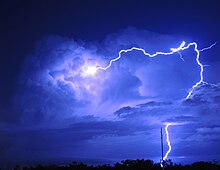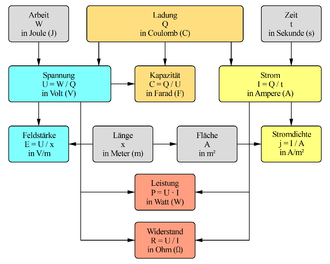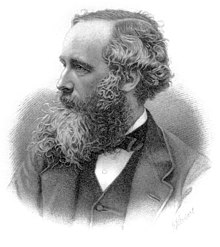electricity
Electricity (from the Greek ἤλεκτρον ēlektron " amber ") is the physical generic term for all phenomena that are caused by static or moving electrical charges . This includes many phenomena known from everyday life such as lightning or the force of magnetism . The concept of electricity is not strictly defined in natural science, but certain properties are included in the core area of electricity:
- The electric charge . It is a property of certain atomic particles such as negatively charged electrons and positively charged protons , which are known as charge carriers, and is measured in units of coulombs . The designation positive or negative is chosen arbitrarily. An essential property is that electrical charges of the same name repel each other, while unlike charges attract each other.
- The electric current . It describes the movement of electrical charge carriers, is measured in the unit ampere and is, among other things, the cause of magnetic fields . The accelerated movement of electrical charges generates electromagnetic fields , which are described in the field of electrodynamics and which can propagate in space independently of electrical conductors .
- The electric field describes the state variables of space caused by electric charges, which are called electric field strength and electric potential . The electrical voltage , defined as the potential difference, is usually measured in volts .
Processes in which no change over time or no significant change over time occurs are assigned to electrostatics . Processes in which the change over time has a significant influence are counted as electrodynamics .
History of exploration
Phenomena of electricity are present in the natural environment of man, the best known and most spectacular occurrence is in the meteorology of lightning . The occurrence of the electric shock , which certain fish like the electric ray or electric eel use to catch prey, was in ancient Egypt around 2750 BC. Chr. Known. In ancient times , the ancient Greeks were already familiar with the electrostatic charging of amber (Greek ἤλεκτρον, electron ). This knowledge is ascribed to the natural philosopher Thales of Miletus , who around 600 BC BC described the attraction of amber.
In the 1st century BC Chr. Were Parthian pottery near Baghdad used in 1936 by King William were found and also as Baghdad Battery are known. These vessels contained an iron rod and a copper cylinder that was sealed with asphalt. Tests by the Roemer and Pelizaeus Museum in Hildesheim showed that with this arrangement and grape juice as the electrolyte, a voltage of 0.5 V could be achieved. Its use as a type of battery is controversial.
A targeted and practical application of electricity did not take place until the beginning of modern times . The Briton William Gilbert systematically investigated the electrical charge on many substances with the help of the Versorium and introduced the name "Electrica" (published in 1600). Around 1663, Magdeburg's mayor Otto von Guericke developed a rotatable sulfur ball , which, rubbed by hand, was supposed to demonstrate the cosmic forces (virtutes mundanae) . In 1706 , Francis Hauksbee developed a friction electrifying machine , the ball of which was no longer made of sulfur , but of glass , aimed at researching electrical effects . These and similar electrifying machines served primarily for social amusement in the following decades.
In 1733, the French naturalist Charles du Fay discovered that there were two opposite forms of electrical charge, which he initially called resin and glass electricity . This finding was the basis for the designation as positive and negative electric charge.
The Dutch physicist Pieter van Musschenbroek invented the Leiden bottle , which is also known in Germany as the "Kleist bottle" , in 1745 - independently of, and one year after, Ewald Jürgen Georg von Kleist . The Leiden bottle is considered to be the first capacitor to store electrical charges.
Around 1752 the American Benjamin Franklin found connections with atmospheric electricity according to the already known static electricity. He invented the lightning rod and interpreted the phenomenon as a positive pole and a negative pole.
Around 1770 the Italian physician Luigi Galvani observed the twitching of a dead frog with an electrifying machine on frogs' legs. It became known that electricity can also trigger movement. "Animal" electricity on frogs' legs is transmitted electrochemical energy and the basis of electrochemistry .
In 1775 the Italian physicist Alessandro Volta invented the electrophore , a device for separating charges with the help of influence . Five years later he developed the voltaic column , which consists of the metals copper and zinc and an electrolyte . This battery made it possible for the first time to generate electricity without friction, only from stored chemical energy. For many years the voltaic column was the most important device for generating direct current .
At the end of the 18th century, Charles Augustin de Coulomb , Joseph Priestley , Henry Cavendish and John Robison independently found and described the law describing the force between two electrical charges, known as Coulomb's law . The German physicist Georg Simon Ohm formulated the fundamental relationship between electrical current and electrical voltage at linear electrical resistances . This connection is later known as Ohm's law .
On May 2, 1800, the British chemists William Nicholson and Anthony Carlisle succeeded for the first time in conducting an electric current through water with a direct voltage and thus breaking it down into its basic chemical components, hydrogen and oxygen. Both of them are the discoverers of electrolysis .
Around 1810, the chemist Humphry Davy created an arc between two carbon pins that were connected to a battery as a power supply , thus laying the foundations for the carbon arc lamp .
Around 1820 Hans Christian Ørsted observed the deflection of a magnetic needle by the influence of electricity. André-Marie Ampère , a French physicist, interpreted and described the strength of the magnetic field deflection as a function of the current strength. He invented the " ammeter ", the theory of the electric telegraph , first used by Carl Friedrich Gauß and Wilhelm Eduard Weber , and the electromagnet . He is the founder of the theory of electromagnetism and namesake of the physical unit of electrical current amperes .
The British physicist Michael Faraday is considered one of the founders of electrodynamics . He formulated the law of induction for the first time and dealt with the laws of electrolysis in further work . In doing so, he laid the foundations for the invention of telegraphy . In 1864, the Scottish physicist James Clerk Maxwell conceived the basic theory of classical electrodynamics in the form of Maxwell's equations and thus combined the effects of static and moving charges and their fields to describe electromagnetic phenomena. From these laws he deduced the existence of electromagnetic waves . He identified light as a manifestation of electromagnetic waves.
From 1830, after the necessary laws were known, electricity began to be widely used. These technical applications are summarized under the term electrical engineering . Since 1831, several researchers have experimented with using electromagnetism for electrical drives and for electromechanical power generation. This was achieved independently in 1832 by the French Hippolyte Pixii and the Italian Salvatore Dal Negro . In 1834 the American Thomas Davenport registered a patent for an electric locomotive. Samuel FB Morse built the first usable telegraph in 1833. With the telegraph line he set up from Washington to Baltimore and the Morse code developed by one of his employees, the age of electrical communication began in 1844 - and with it, simultaneity. In the years 1843/1844 Henri Adolphe Archereau and Louis-Joseph Deleuil succeeded for the first time in the electric lighting of a public square with carbon arc lamps on the Place de la Concorde in Paris .
The generation of electricity (and thus the possibility of an electric drive) with an electric machine without a permanent magnet was achieved in 1851 by the Slovak Ányos Jedlik , in 1854 by the Dane Søren Hjorth , who received the English patent No. 2198 for it in the same year, and in 1866 by Werner von Siemens , which brought them to series production.
In 1882 an electrical power supply was installed over a large distance for the first time, with the 57 km long direct current line Miesbach – Munich . In 1886 Nikola Tesla, with the help of his sponsor George Westinghouse, founded the electrical power transmission using alternating current that is common today . In 1891 the first long-distance transmission of the three- phase alternating current common in power engineering today was achieved with three-phase current transmission from Lauffen to Frankfurt over 176 km.
In the following years there was an increasing specialization in electrical engineering . While still closely with the engineering associated electrical power engineering served to the power supply of homes, businesses and factories, the branch of pursuing communications technology to transmit information such as news with slight delays over long distances the goal. Guglielmo Marconi carried out the first radio tests in Bologna around 1895 . He built on the discoveries of Heinrich Hertz , Alexander Stepanowitsch Popow and Édouard Branly . On March 24, 1896 , Popow succeeded in transmitting the words "Heinrich Hertz" by radio during a demonstration in front of the Russian Physical Society.
The 20th century is characterized by a strong expansion of the theoretical structure. The classical electrodynamics of Maxwell was extended to relativistic electrodynamics within the framework of the special relativity theory . In the middle of the 20th century, especially through the work of the American physicist Richard Feynman , the expansion to quantum electrodynamics took place . For this work, Shin'ichirō Tomonaga , Julian Schwinger and Richard Feynman received the Nobel Prize in Physics in 1965 “for their fundamental achievement in quantum electrodynamics, with profound consequences for elementary particle physics”. Quantum electrodynamics (QED) is in the context of quantum physics , the quantum field theoretical description of electromagnetism . In 1979 Sheldon Glashow , Steven Weinberg and Abdus Salam received the Nobel Prize in Physics "for their contributions to the theory of the united weak and electromagnetic interaction between elementary particles, including the prediction of weak neutral currents" ( Electroweak Interaction ).
In the technical application of the 20th century, Ferdinand Braun developed the cathode ray tube in 1897 , which was the basis of the first television sets. In 1911 the Dutchman Heike Kamerlingh Onnes was the first person to observe the effect of superconductivity . In the middle of the 20th century, Walter H. Brattain , John Bardeen and William Shockley developed the transistor , which was the basis of the first integrated circuits and computer technology in the following years .
Electricity in everyday life
In today's everyday life, electricity in the sense of electrical energy is indispensable, which people usually only become aware of again when the supply network fails. However, 1.4 billion people worldwide have no access to electrical energy. This energy source is almost always generated in power plants ; it is distributed across the board by companies in the power grid (see electricity / tables and graphics ). For over a century, applications of electricity such as electric light , heat, and power have increasingly determined human life. Electricity is of major importance in the field of communication technology and information technology .
In addition to lightning, electricity in its natural form also occurs less spectacularly in the form of information transmission in the nervous systems of living things. Only very small tensions occur. Electricity also has different effects on the human body depending on its strength. The strength and duration of the electric current on the human body is essential for electrical accidents . Electric currents from around 30 mA can be dangerous and cause respiratory paralysis and cardiac arrest . Electric current is also used to target people to kill, as is done with the electric chair .
Electricity from solids
Solids that have little or no electrical conductivity are classified according to their behavior in electrical and magnetic fields. The cause of the different behavior of matter in a field is the presence or absence of corresponding dipoles and their behavior. This is described by using the appropriate prefix for both fields as equivalent (cf. magnetism of solids ). It means:
| Elektrikum | Explanation |
|---|---|
| dielectric | There are no electrical dipoles in dielectric materials. Corresponding dipoles can, however, be induced by external electric fields. In contrast to diamagnetic materials, the dipoles in dielectric materials are oriented in the direction of the electrical field (electrical permittivity ε r > 1). These dipoles only exist as long as the material is in an electric field. Every form of matter - whether solid, liquid or gaseous - is dielectric. |
| Paraelectric | If there are dipoles that can be orientated in the matter, but which do not form a stable long-range order, these substances are referred to as paraelectric. In addition, they are aligned in the field direction by an externally applied electric field. The resulting polarization disappears when the field is switched off. The following also applies here: ε r > 1. In contrast to the dielectric case, the electrical permittivity is temperature-dependent. Thus, both effects can be distinguished. Liquids and gases can also be paraelectric. |
| Ferroelectric | In a ferroelectric all dipoles are parallel to each other. If you take a ferroelectric from an electric field, an electric polarization remains. Ferroelectrics also belong to the group of piezoelectrics. |
| Antiferroelectric | In an antiferroelectric, the dipoles in two sub-grids are mutually antiparallel. This means that the polarization of the sublattices is of the same amount but oriented in the opposite direction. Therefore, antiferroelectrics have no polarization outside of an electric field. |
| Ferrielectric | The conditions in a ferrielectric are similar to those in an antiferroelectric, that is, the dipoles are also mutually antiparallel in two sublattices. In contrast to the antiferroelectric, the respective polarizations are not the same amount. Therefore, like ferroelectrics, they have polarization when they are removed from an electric field. |
The prefixes Ferro-, Ferri- and Antiferro- denote different forms of a long-range order of dipoles. The areas of the same order are called domains. They correspond to the Weiss domains in magnetism. All of these materials are solids, many of which have a high temperature paraelectric phase. The orientation of the dipoles can be reversed by a sufficiently strong external field. This leads to a hysteresis . The individual forms can be distinguished by the type of hysteresis.
meaning
Natural sciences
The various phenomena of electricity are objects of consideration in parts of physics and chemistry :
- Electrostatics deals with static electrical charges, charge distributions and electrical fields of charged bodies.
- Classical electrodynamics deals with magnetic fields that are constant over time, electric and magnetic fields that change over time, and electromagnetic waves.
- Quantum electrodynamics is an extension of classical electrodynamics to include the quantum field theoretical description of electromagnetism .
- Solid state physics describes, among other things, the behavior of electrical charges in solid substances such as electrical conductors , semiconductors and non-conductors , as well as thermal , pyro and piezoelectricity .
- Electrochemistry describes the relationship between electrical and chemical processes as they occur in batteries and accumulators .
Engineering
The electrical engineering refers to that area of engineering science and technology , which deals with all aspects of electricity. The spectrum ranges from electrical energy engineering such as power generation , through regulation , control and measurement technology , to electronics , micro- and nanoelectronics , to communications engineering and automation technology as a degree in electrical engineering. Theoretical electrical engineering forms the theoretical foundation .
The great importance of electrical energy is that it can be transported in high-voltage lines and easily converted into other types of energy such as mechanical work, heat, light or sound. However, electrical energy can only be stored poorly and must be converted into other energy sources such as chemical energy in accumulators or into potential energy such as in pumped storage power plants.
Economics
The electricity industry denotes that area of the energy industry that deals with all aspects of electricity.
literature
- Klaus Heuck, Klaus-Dieter Dettmann, Detlef Schulz: Electrical energy supply. Generation, transmission and distribution of electrical energy for study and practice . 8th, revised and updated edition. Vieweg + Teubner, Wiesbaden 2010, ISBN 3-8348-0736-2 .
- Adolf J. Schwab: Electrical energy systems - generation, transport, transmission and distribution of electrical energy . 3. Edition. Springer, Heidelberg 2012, ISBN 978-3-642-21957-3 .
- Dirk Johannes Willem Sjobbema: History of Electronics . Elektor, Aachen 1999, ISBN 3-89576-066-8 .
Web links
Individual evidence
- ^ Peter Moller: BioScience, Review: Electric Fish. Edition 11, Volume 41, December 1991, pp. 794–796, DOI: 10.2307 / 1311732 .
- ^ Willem D. Hackmann: Electrostatic Machine. In: Robert Bud, Deborah Jean Warner (Eds.): Instruments of Science. An Historical Encyclopedia. Garland, New York et al. 1998, pp. 221-224.
- ↑ Max Le Blanc: Textbook of Electrochemistry. Verlag Oskar Leiner, Leipzig 1922, p. 33 ff.
- ↑ May 2nd, 1800. In: funkzentrum.de. Retrieved March 25, 2019 .
- ↑ Lack of energy. In: Süddeutsche Zeitung. 23 September 2010, p. 16.
- ^ Dieter Meschede, Christian Gerthsen: Gerthsen Physics . Springer, 2010, ISBN 978-3-642-12893-6 , pp. 403-411 .





